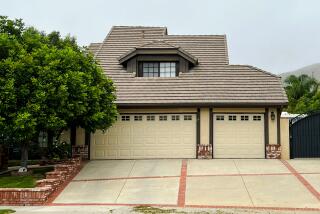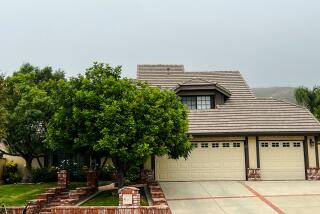Where Netflix’s ‘Rebecca’ found its Manderley
- Share via
LONDON — Wayne Manor, Windsor Castle, Croft Manor and now Manderley. Hatfield House may not be the best-known location outside the U.K., but the Jacobean estate has played some of the most famous homes in film.
Built in 1611 by Robert Cecil, the 1st Earl of Salisbury, Hatfield House is just north of London in Hertfordshire. The expansive grounds and stunning architectural features have made appearances in dozens of Hollywood movies and TV shows shot in the U.K. In recent years, Hatfield has played host to three to four major Hollywood productions every year alongside smaller shoots — such as the Jonas Brothers’ recent music video for “Sucker.”
Last summer, Ben Wheatley’s new adaptation of “Rebecca” — now streaming on Netflix — used Hatfield as one of several stately homes to composite the famous (and fictional) Cornwall estate of Manderley, made famous in Daphne du Maurier’s 1938 novel and Alfred Hitchcock’s 1940 Oscar-winning film adaptation.
“With Manderley, the house is like an onion that is still unpeeled,” explains “Rebecca” production designer Sarah Greenwood, who used Hatfield alongside several other historic homes — including Cranborne Manor, which supplies exteriors and is also owned by the Salisbury family. “Every which way and every corner you turn there’s something new and different. We explore all of that through [the new Mrs. De Winter’s] eyes. You don’t understand where you are. You don’t get the geography. It was literally an amalgam of many houses to capture Manderley, but even if we had found the perfect house we never would have caught it all or found our way around it.”
“We decided the house just doesn’t exist anywhere in the U.K. — it’s much bigger and much grander than anything you’d be able to find,” Wheatley adds. “That’s where we started to think about the house being a composite of many different houses. We could take the best bits of lots of different great British houses, with different periods and different scales, and glue it all together to make Manderley.”
Hatfield House has several notable rooms, including the Marble Hall, the Armory and the Long Gallery, the last of which is notable for its gold-leaf ceiling. The black and white checkered floors, which appear throughout the house, are especially recognizable — they were heavily featured in the 2018 best picture nominee “The Favourite,” which used Hatfield as Queen Anne’s palace.
Wheatley used several rooms at Hatfield for Manderley’s interior, and Greenwood incorporated some of the existing furnishings and decor in her final design.
“There were lots of rooms there we could just jump off into,” Wheatley notes. “It gives you five or six different looks straight away. But the other reason I think people use Hatfield is because they’re very amenable. You can’t use atmosphere or smoke in any of the National Trust building, but you can at Hatfield. They allow you to set fires in their fireplaces, which you can’t do in other buildings.”
For Wheatley, Hatfield House is just one element of Manderley, and that hodgepodge of houses and styles is part of what makes the stately location interesting for the viewer — and overwhelming for the protagonist, known only as the new Mrs. De Winter (Lily James). She arrives at the home after marrying the wealthy Maxim de Winter (Armie Hammer) following a brief courtship.
“I imagined the house is basically a storage box for all the stuff the De Winters pillaged from the different countries they had business in,” Wheatley says. “It was like a history of Britain, in a way. The same way the empire grew and then failed, the De Winters were that kind of family. ... When the second Mrs. De Winter turns up, it’s heavy with heritage and history, and it’s all a bit crushing. It’s like a mausoleum to itself.”
Hatfield House is privately owned by the 7th Marquess and Marchioness of Salisbury. The family resides in the house, in a separate, private wing, and all filming requests go directly to them.
“Our first port of call is going to the family to explain roughly what the film is about,” says Helen Landau, who serves as Hatfield House’s director of operations. “Sometimes there’s a request to see the script, obviously confidentially, to make sure they’re comfortable with what that film is. We have turned productions away in the past if we feel they don’t fit into the history and setting of the location, etc. The family has a big say in it.”
That relative ease of access has benefited a lot of productions. Originally, Netflix’s “Enola Holmes,” starring Millie Bobby Brown as the younger sister of Sherlock Holmes, was scheduled to use Audley End — an English Heritage property — as its Basilwether Manor, where the film’s final duel takes place. Deep into the negotiations with Audley End, the house pulled out, leaving the team without a location. The production always had Hatfield on its longer list of options, and the estate quickly accommodated requests.
“Hatfield is a private house, so you don’t have that kind of potential hurdle in the process,” says Bill Darby, supervising locations manager on “Enola Holmes.” “You go straight to Lord Salisbury himself through the estate manager and put your plans to him, and he says, ‘Yes, I’m going to be away on these dates but I want the house back on this date.’ And you’re in. You can rely on them.”
Because the “Enola Holmes” finale sequence involves gunshots and fighting, production designer Michael Carlin had to put a fake replica floor and fake rubber walls into the Armory, alongside several replacement suits of arms that could be used for bullet hits.
“One of the ironies of working in those houses is that you go there for a particular feature and you end up having to reproduce that feature just so all the equipment and the actors can interact with it in the way that you want them to,” Carlin says. “We had to put a lot of rubber walls in Hatfield that looked exactly like the real walls behind them. ... There were some changes we needed to make, but within the way the building already felt and looked.”
The first film on Hatfield House’s long official list of productions is Tim Burton‘s 1989 “Batman” (Christopher Nolan’s Batman films also used Hatfield as Wayne Manor), but “Cromwell,” starring Richard Harris and Alec Guinness, shot there as early as 1970.
Since the late ‘80s, the estate has popped up in such franchises as “Tomb Raider,” “Wonder Woman” and “Paddington,” and Landau confirms that films have already returned to the location since production restarted during the coronavirus pandemic. Although the house can be contemporary, it’s most often used as a period location due to its ornate details and careful conservation efforts.
It’s an added bonus that Hatfield House is close to London and to many of the main studios — cast and crew don’t have to travel overnight — and there’s plenty of open land for production trailers on its 10,000 acres.
The house does offer public tours, but only for a limited part of the year, and Landau expects fewer tours in the future to accommodate more filming. Hatfield is popular with Hollywood for many reasons, but in the end the appeal goes back to the house itself and how well its slice of history has been preserved.
“There’s a huge amount of period film production going on and there’s a limited number of houses to shoot in,” Carlin notes. “There are only so many houses that were built in the earlier centuries. Hatfield is an extraordinary house, and it’s an extraordinary intact bit of historic architecture.”
More to Read
Only good movies
Get the Indie Focus newsletter, Mark Olsen's weekly guide to the world of cinema.
You may occasionally receive promotional content from the Los Angeles Times.










